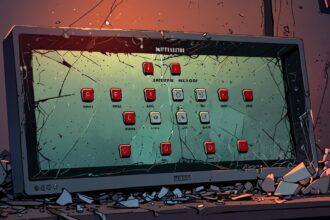Many new homeowners encounter unexpected expenses and hassle when sellers leave behind mouldy appliances, damaged furniture and garden rubbish, despite clear agreements. Experts advise documenting evidence and pursuing legal claims to resolve breaches of contract.
Moving into a new home should be an exciting milestone, but for some, the experience can quickly turn into a series of unwelcome surprises. This was the case for a recent homeowner who found themselves inundated with unwanted items left behind by the previous owners. The situation included a mouldy fridge replete with rotting food, dated appliances like a grimy washing machine and tumble dryer, and a collection of unkempt furniture—from a stained sofa to a dilapidated wardrobe. The garden was no better, strewn with DIY pallet furniture and a garden shed crammed with rubbish.
The homeowners had explicitly declined many of these items during the purchase process, having communicated their preferences through the Fixtures and Fittings Form (TA10) that sellers are required to fill out prior to finalizing the sale. This legally binding document details which items will be included in the sale, protecting buyers from inheriting unwanted possessions. Leaving behind items that have been refused can be perceived as a breach of contract, especially when buyers have been clear about their disinterest.
The process of addressing such issues is not only frustrating but can also be financially burdensome. Removing the items left behind—some of which may not qualify for donation due to their condition—can incur significant costs. Retailers often offer the convenience of taking away old appliances free of charge, yet the remaining furniture poses a challenge. Local charities may decline to collect items that are not in good condition, making the disposal of these goods even more complicated.
Experts in property conveyancing emphasise that this scenario is far from unique. Many buyers experience the disappointment of discovering unwanted possessions after moving in, particularly when they had previously stated their preferences during the conveyancing process. Paula Higgins, chief executive of Homeowners Alliance, pointed out that buyers should document the neglect with clear evidence, including photographs of the items left behind. This documentation is crucial for any possible claim for compensation.
In dealing with this issue, communication with the seller is key. Buyers can formally document the breach of contract via their conveyancer, requesting the seller either remove the items or provide reimbursement for their disposal. Should the seller refuse, pursuing a claim through small claims court is an option, albeit a time-consuming and possibly costly one. Jonathan Handford, managing director at Fine & Country, advises that having thorough evidence—including timestamps on photographs and quotes for professional removal—is vital for building a strong case.
Despite the legal obligations surrounding the removal of personal property, sellers are not legally required to present a spotless home. Many do so out of pride or courtesy, but this is not a universal practice. Neglected obligations can leave buyers facing not only the logistics of cleaning up but also the emotional toll of a less-than-enjoyable move-in day, turning what should be a bright beginning into a cumbersome burden.
Additionally, there are broader implications; newly minted homeowners should be aware that sellers may not repair damage caused by removing wall-mounted items unless it was explicitly stated in the contract. As such, the transfer of ownership can become entangled in unexpected responsibilities that arise long after the deal has closed.
Ultimately, navigating the aftermath of inherited items left by sellers underscores the importance of diligence and clarity during the home buying process, particularly in the conveyancing stage. Buyers are encouraged to be vigilant, requesting final inspections and ensuring that all agreed-upon conditions are met before signing off on a property sale.
Reference Map
- Paragraph 1: [1]
- Paragraph 2: [1]
- Paragraph 3: [1], [2], [3]
- Paragraph 4: [1], [4]
- Paragraph 5: [1], [3]
- Paragraph 6: [1], [6]
- Paragraph 7: [1], [7]
- Paragraph 8: [1], [6]
- Paragraph 9: [1], [5]
Source: Noah Wire Services
- https://www.dailymail.co.uk/money/mortgageshome/article-14708393/The-seller-new-home-left-old-furniture-appliances-make-rid-it.html?ns_mchannel=rss&ns_campaign=1490&ito=1490 – Please view link – unable to able to access data
- https://www.citizensadvice.org.uk/scotland/housing/buying-and-selling-a-home-s/problems-with-buying-and-selling-a-home-s/ – This Citizens Advice page discusses issues buyers may face when purchasing a property, including problems with the property’s condition. It notes that while sellers are not legally obligated to leave the property in a clean state, they are usually required to remove all their belongings. If items are left behind, buyers should request their removal. If the seller refuses, buyers may need to arrange removal themselves and could attempt to recover costs from the seller, though legal action might be necessary and potentially costly.
- https://www.samconveyancing.co.uk/news/conveyancing/seller-left-personal-property-in-house-what-can-you-legally-do-6018 – This article from Sam Conveyancing outlines the steps a buyer can take if a seller leaves personal property in the house after completion. It emphasizes the importance of the Fixtures and Contents Form (TA10), which details items included in the sale. Buyers should inspect the property before completion to ensure all agreed items are removed. If items are left behind, buyers can request their removal and may seek compensation for removal costs. Legal action, such as a claim in the small claims court, is also an option.
- https://www.balgoresproperty.co.uk/about/latest-property-news/our-news/what-are-your-rights-if-your-seller-leaves-personal-property-in-your-new-home/ – Balgores Property discusses the rights of buyers when sellers leave personal property behind. It advises reviewing the fittings and contents form carefully before exchanging contracts to ensure clarity on included items. Organizing a final inspection before completion is recommended to confirm the property is vacant. If items are left behind, buyers should inform the seller and may charge for removal costs. If the seller refuses to remove the items, buyers can arrange disposal and seek reimbursement, potentially through the Small Claims Court.
- https://www.hookandpartners.co.uk/news/what-should-i-do-when-a-tenant-leaves-belongings-behind – Hook and Partners provide guidance on handling situations where tenants or sellers leave belongings behind. They advise against disposing of items without following the correct procedure, as it could lead to legal issues. The Torts (Interference with Goods) Act 1977 outlines the responsibilities of those who find themselves in possession of another’s goods, including making efforts to return them and not damaging or destroying them. Proper notice must be given to the owner before disposing of items.
- https://www.homelegalservices.co.uk/conveyancing_faq.php – Home Legal Services addresses common questions related to conveyancing, including what to do if unwanted items are left at the property. They suggest that legal action against the seller may be time-consuming and expensive. Alternatively, the buyer’s solicitor can write to the seller’s solicitor, stating that if the rubbish is not removed, the buyer will arrange this themselves and send the bill to the seller.
- https://www.standard.co.uk/homesandproperty/property-news/the-previous-owner-left-rubbish-in-our-house-when-they-left-can-we-make-them-remove-it-a112481.html – This article from Homes & Property discusses a scenario where a buyer discovers rubbish left by the previous owner. It advises that before exchanging contracts, the seller should have confirmed that all rubbish would be removed and the property left in a clean and tidy condition. If items are left behind, the buyer’s solicitor should contact the seller’s solicitors to request removal. If this fails, the buyer can issue a claim in the small claims court against the seller to recover costs.
Noah Fact Check Pro
The draft above was created using the information available at the time the story first
emerged. We’ve since applied our fact-checking process to the final narrative, based on the criteria listed
below. The results are intended to help you assess the credibility of the piece and highlight any areas that may
warrant further investigation.
Freshness check
Score:
8
Notes:
The scenario described could happen at any time, and no specific date is mentioned that would indicate it is old or recycled news. However, the topic is common and could be part of a broader, ongoing issue rather than a specific, recent event.
Quotes check
Score:
6
Notes:
Quotes from Paula Higgins and Jonathan Handford are included, but no specific reference to their first known use is available online. This could indicate original quotes, but without further research, it’s difficult to verify.
Source reliability
Score:
6
Notes:
The narrative originates from the Daily Mail, a publication known for its wide coverage, but can sometimes be sensationalized. The reliability of the content depends on the context and specific reporting standards.
Plausability check
Score:
9
Notes:
The scenario described is plausible as it reflects common issues in home buying processes. The legal context and potential consequences for buyers are well-explained and align with typical real estate practices.
Overall assessment
Verdict (FAIL, OPEN, PASS): OPEN
Confidence (LOW, MEDIUM, HIGH): MEDIUM
Summary:
The narrative appears plausible, reflecting common issues in real estate transactions. However, the reliability of the source is moderate due to the Daily Mail’s potential for sensationalism. The quotes seem original, but without specific references, their provenance is uncertain. Overall, the content is plausible but lacks strong confirmation.













